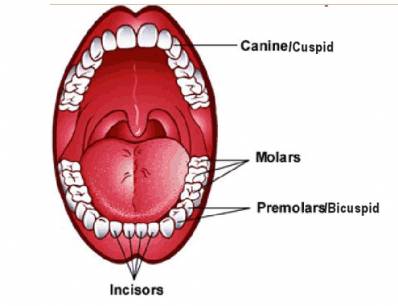Did you know that the average adult has 32 teeth, each one specialized for a specific function? Our teeth do more than just chew—they enable us to speak, express emotions, and stay healthy in ways that go beyond the basics. Let’s break down the different types of teeth, what makes them unique, and why each one is so crucial to our everyday lives.
A Dental Breakdown: Types and Numbers
Humans generally have four types of teeth, each serving a unique purpose. Here’s a breakdown of each type and how many of each we typically have:
- Incisors: 8 teeth (4 on top, 4 on bottom)
- Canines: 4 teeth (2 on top, 2 on bottom)
- Premolars: 8 teeth (4 on top, 4 on bottom)
- Molars: 12 teeth, including 4 wisdom teeth (6 on top, 6 on bottom)
It’s also interesting to note that, according to a recent survey by the American Dental Association (ADA), nearly 85% of people have their wisdom teeth removed. That leaves most adults with a total of 28 teeth.
The Incisors: Your Precision Cutters
Incisors are the flat, sharp-edged teeth at the front of your mouth. They are designed for biting into foods like apples, carrots, and sandwiches. A common issue with incisors is chipping, especially among people who play contact sports. Dr. Hannah Roberts, a dental specialist, notes that chipped incisors are one of the most common dental emergencies she sees. “People underestimate the importance of wearing mouthguards, even for seemingly low-contact activities like skateboarding,” she says.
Fun Fact: Incisors are among the first teeth to develop in babies. They often emerge around 6 to 10 months of age, allowing infants to start eating more solid foods.
The Canines: Your Tearing Tools
The canines, or cuspids, are the pointed teeth on either side of your incisors. They’re crucial for tearing food—think about ripping a piece of jerky or a tough piece of bread. These teeth are the longest in the mouth and are incredibly strong, thanks to their deep roots.
Clinical Example: Canine teeth are often used in orthodontics as an anchor point. In a 2019 study published in the Journal of Orthodontics, it was found that canine teeth provide superior stability during braces treatment compared to other teeth, thanks to their robust roots.
Premolars: The Bridging Teeth
Next up are the premolars, also known as bicuspids. These teeth are uniquely positioned between the canines and molars, and they serve a dual purpose: they help tear food, but they also assist in grinding it. This makes them an essential transition between tearing and chewing.
Dental Insight: Did you know that many adults lose their premolars due to tooth crowding and orthodontic treatments? Statistics from the American Association of Orthodontists suggest that about 15% of adults have at least one premolar removed to make room for better alignment.
Molars: The Heavy Lifters
Finally, we have the molars. These are the real workhorses of your mouth, responsible for grinding and breaking down food to make it easier to swallow and digest. Molars have a wide, flat surface with several cusps—perfect for crushing foods like nuts, grains, and even tough vegetables.
Common Dental Issue: Molars are prone to cavities, more so than other teeth. The deep grooves and pits on the surface of molars make them susceptible to plaque buildup. Dr. Sarah Green, a general dentist, often recommends sealants for molars in children, which can reduce the risk of cavities by up to 80%.
Wisdom Teeth: A Vestigial Mystery
Molars also include wisdom teeth, often seen as the troublemakers. Anthropologists believe that wisdom teeth were necessary for our ancestors, who had larger jaws and needed extra molars to chew tough, uncooked plant material. Today, due to dietary changes and smaller jaw sizes, wisdom teeth often become impacted or fail to erupt properly, leading to complications.
Medical Example: Impacted wisdom teeth are known to cause severe pain, inflammation, and even damage to adjacent teeth. According to the National Institute of Dental Research, around 10 million wisdom teeth are extracted in the U.S. annually, costing patients and the healthcare system over $3 billion every year.
Teeth and Their Functions: More Than Just Chewing
Beyond their roles in chewing, teeth play an essential role in speech. Try saying the word “think” without your incisors—it would come out as a muffled “ink”. Proper tooth alignment also contributes to facial aesthetics. Canine teeth, for instance, provide crucial support for the lips, enhancing the contours of your face.
The Human Side of Teeth: Real-Life Examples
Consider the case of James, a middle-aged runner. James lost his molars due to years of neglect, relying mostly on his front teeth for eating. As a result, James developed temporomandibular joint (TMJ) pain, a common side effect of improper bite force distribution. “It took losing my molars to realize just how crucial each tooth is,” James reflects. Now, with dental implants, his bite is properly balanced, and his TMJ symptoms have subsided.
Our Editorial Advice: Take Care of All 32!
Our teeth might all look similar, but their functions are as varied as the jobs in a bustling workplace. Neglecting even one type of tooth can have far-reaching effects on your overall health. Our advice? Brush, floss, and make those dental appointments. Whether it’s a tiny incisor or a hardworking molar, every tooth deserves the care that allows it to serve you—pain-free and effectively—for a lifetime.
Remember, those wisdom teeth might seem like a vestigial nuisance, but they are a reminder of our evolutionary journey. And while we may not need them today, every tooth tells a story—past, present, and future.






